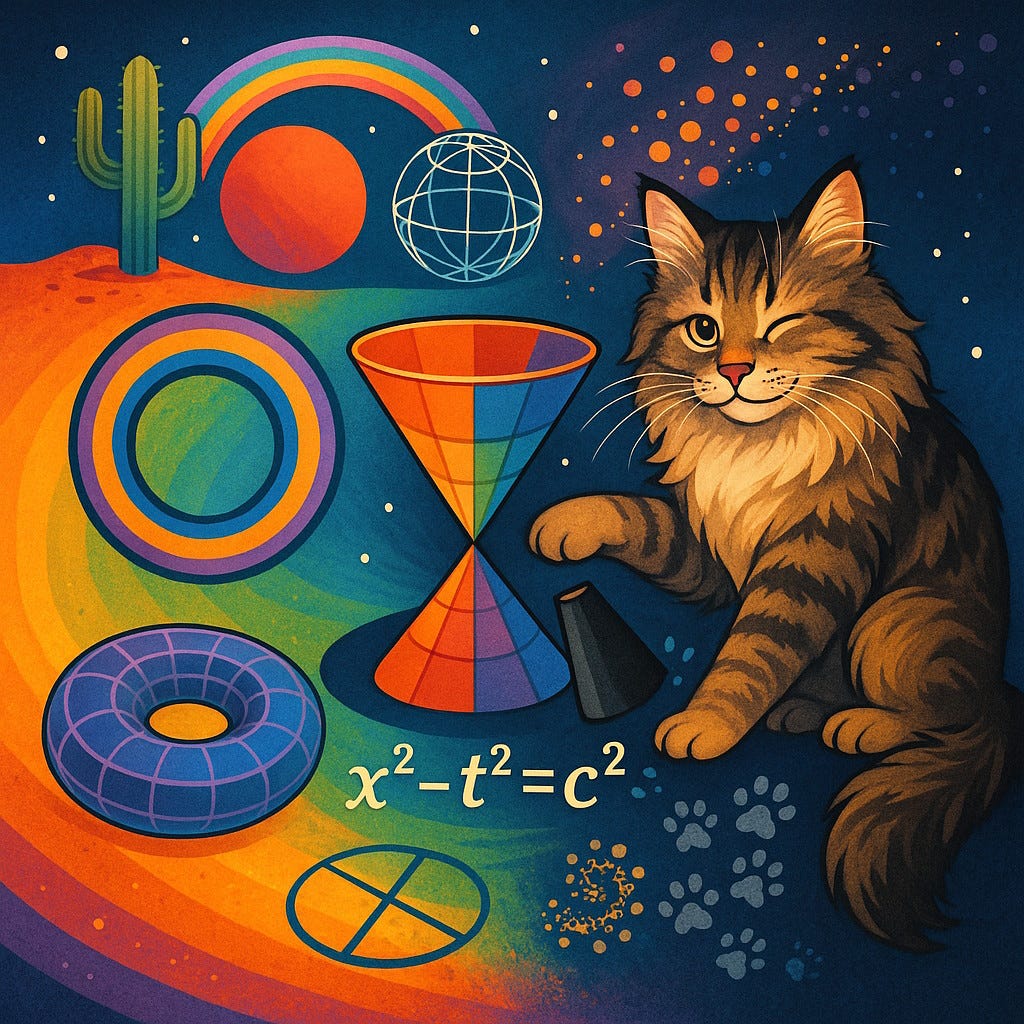From Spheres and Circles to Spacetime
Evolving Coordinates
This is a test. Out of sequence. I am testing how my math-physics posts will survive in the Substack environment.
Here we continue from the June circles. There will be changes in the notation. Changes always create temporary chaos. We have to learn how to survive when our environment undergoes change. Survival of the fittest — that rule seems to govern all evolution in the universe. Survival of the fittest and adaptation. A cactus that retains water well survives in arid deserts. A person who learns from failure may “survive” mentally and socially better than someone who rigidly resists change. Will my readers survive after this post?
But why the changes? Here is the reason. The Lie sphere geometry was discovered while studying the geometrical properties of spheres. It was pure mathematics, but, surprisingly, it has found application in relativistic physics. The idea goes as follows. Consider the simple equation of a circle on the plane:
Now rewrite it as
Now substitute
This is the equation of the light cone of special relativity. The radius of the circle expands with the velocity of light. The value of this radius can serve as a time coordinate of an event. If a circular wave was created at a point x and time t, when it reaches the origin x=0, its radius has the value r=ct. Therefore it should not be surprising that studying circles we study spacetime of special relativity. This is how it will go.
We will denote the coordinates of the 2+1 dimensional Minkowski space by x,t, and coordinates in the 5-dimensional space R3,2 of Lie spheres by ξ = (ξ0,ξ1,ξ2,ξ4,ξ5) with the quadratic form
ξ·ξ = (ξ0)2 + (ξ1)2 + (ξ2)2 - (ξ4)2 - (ξ5)2. (0)
With
q(x,t) = x2-t2, (1)
the formula (12) of the previous post embeds the Minkowski space in the projective quadric Q+ would read:
ξ(x,t) = ½(1 − q(x, t)) e0 + x + t e4 + ½(1 + q(x, t)) e5, (2)
Note: In what follows I will use the term 'projective' to mean 'semi-projective', where instead of lines we consider half-lines in R3,2 (λ>0, instead of λ≠0 in the equivalence relation).
Environmental change — the fittest survive.
To obtain (2) we used a particular convention for representing oriented spheres (circles in our case) as points of a space with 1+2 more dimensions. Let us compare our formula with the formula from the paper "On organizing principles of discrete
differential geometry. Geometry of spheres" by A.I. Bobenko and Yu. B. Souris, Russian Math. Surveys 62:1 1–43. Here is the corresponding extract from this paper:
To relate it to our Eq. (2) we replace, in the formula (4) of the paper, c by x, r by t, and substitute (3) to obtain
ξ= - ½(1 − q(x, t))eN+1 + x + teN+3 + ½(1 + q(x, t))eN+2.
We see eN+3 corresponds to our e4, eN+2 corresponds to our e5, and eN+2 corresponds to our -e0. It will be more convenient for us in the future to follow the convention used in this paper, particularly regarding the sign of e0. On the other hand, it will also be convenient to number the indices as 1,2,3,4,5. Thus, in what follows, we will use the basis E1=e1, E2=e2, E3=e4, E4=e5, E5=-e0. We will write X=(XA), A=1,...,5):
X = XAEA,
with
X·X = (X1)2 + (X2)2 -(X3)2+(X4)2- (X5)2.
For this reason in the future we will replace our embedding formula (2) with the following one:
X(x,t) = x + t E3 + ½(1 + q(x, t)) E4 - ½(1 − q(x, t)) E5 , (2a)
In our coordinates it reads:
X1(x, t) = x1,
X2(x, t) = x2, (3)
X3(x, t) = t,
X4(x, t) = ½(1 + q(x, t)),
X5(x, t) = -½(1 − q(x, t)) ,
We notice that
X4(x, t) - X5(x, t) = 1. (4)
However, this last formula is not invariant under selecting an element from the equivalence class defining the projective space. The invariant formula is, instead:
X4(x, t) - X5(x, t) > 0. (5)
Notice that we have
X(x,t)·X(x,t) = 0, (6)
and this equation defines the projective null cone in the projective space — our Q+ universe. It then follows from the definitions that Q+ splits into a disjoint union of three sets:
Q+ = M+ ∪ M- ∪ M∞, (7)
where
M+ = {[X]: X0+X5 >0}, (8)
M- = {[X]: X0+X5 <0}, (9)
M∞ = {[X]: X0+X5 = 0}. (10)
The sets M+ and M- are open in Q+, the set M∞ is closed (Why?). The map (x,t) ⟼ [X(x,t)] is bijective from R4 to M+. Similarly the map (x,t) ⟼ [-X(x,t)] is bijective from R4 to M-. The map [X] ⟼ [-X] is a bijection from M+ onto M-.
Exercise 1. Prove the above statements.
Exercise 2. Prove that M+ ∩ M- = ∅.




I am genuinely quite curious to see where you take this. 😊